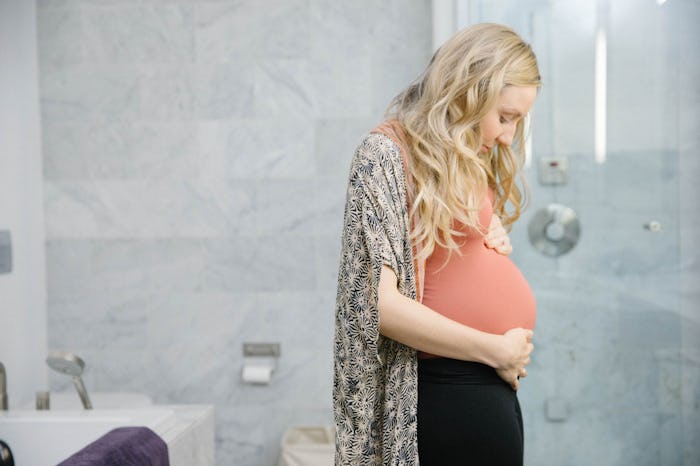Life
They May Be Uncomfortable, But Do Braxton Hicks Contractions Mean Labor's Coming?
So you're seven months pregnant, just chugging along to your due date when suddenly your belly bunches and tightens. If you've never felt the uncomfortable clench of Braxton Hicks contractions, you might easily confuse them with labor pains and worry that your baby wants to make a very early entrance in the world. They're weird and sometimes painful, but do Braxton Hicks contractions mean labor is coming?
Not necessarily, unless you consider each developmental milestone in your pregnancy as a signal that labor is on the way. Braxton Hicks contractions are technically the body's way of preparing for labor and delivery, but the American Pregnancy Association says they do not mean your baby's arrival is imminent. Beginning as early as the second trimester, the 30 to 60 second-long contractions are markedly different than labor contractions, which are painful and come at regular intervals. Medical experts believe that Braxton Hicks play a role in toning the uterus for labor and delivery and might also contribute to softening of the cervix, but they aren't an indication that labor is underway.
"They start much sooner than labor usually. However, some people may not be taunted with these lovely irregular contractions before labor occurs," says Dr. Christine Greves, an OB-GYN at Orlando's Winnie Palmer Hospital in an interview with Romper. "While nothing in pregnancy is an all or none thing, just because you're having Braxton Hicks contractions does not mean you're in labor."
How do you tell the difference? First, practice contractions come at irregular intervals and remain relatively weak, whereas labor contractions are regularly timed and increase in both speed and intensity. Braxton Hicks are also not rhythmic and taper off before disappearing altogether — not so much with labor contractions. You can usually alleviate them by changing position or walking around a bit, but your body doesn't care about a light walk when it's trying to eject a baby. If you're confused about which you have because the contractions are so intense, accompanying symptoms of labor pains are lower back ache, loose stools, brown-tinged mucus, watery discharge, and increased urination.
While Braxton Hicks contractions are present in all pregnancies, each woman's experience of them is different, ranging from totally unnoticeable to breathtakingly intense. A few triggers for intense contractions include dehydration, sexual or physical activity, or a full bladder, according to the American Pregnancy Association. If the contractions are really intense or just annoying, a good rule of thumb is to do the opposite level of activity you were engaged in at their onset. If you were sitting, stand up. If you were walking, take a rest. Since dehydration is another reliable trigger, drink a tall glass of water as well. False contractions are also a great time to practice breathing and visualization techniques in preparation for labor.
Pre-term labor, however, is a thing. It's important to recognize that even though you may be a pro at managing Braxton Hicks contractions, real contractions can also happen before your baby is full term. It pays to be aware of the symptoms of real labor pains so you don't pass them off as more false contractions. Doctors sometimes recommend decreased activity so moms-to-be can more easily distinguish between very strong false contractions brought on by physical movement and labor contractions.
"Sometimes it’s hard to distinguish between true contractions and false ones and if you take out any confounding variables that can contribute to the false contractions, then that might help you determine if they are regular contractions," Dr. Greves continues.
Real contractions, which serve to dilate the cervix so the baby can pass through during delivery, feel like intense menstrual cramps and are usually accompanied by other symptoms of labor, according to WebMD. In addition to regular and intense cramping, real contractions are accompanied by lower back pain, bloody show, or discharge of the mucus plug, and the breaking of the amniotic sac. If any of these symptoms appear before your doctor has given you the all clear to let labor proceed, you should contact them for medical care. Many doctors consider babies to be full-term at 37 weeks and will let labor progress naturally should your body trade out Braxton Hicks for real contractions.
By being able to differentiate between Braxton Hicks and labor contractions, you can avoid being one of those sad moms-to-be on television who keep getting excited about their impending arrival only to be sent home from the hospital because they were experiencing false labor. Remember, the real cramps will come soon enough, you just have to let your body practice until it does.
